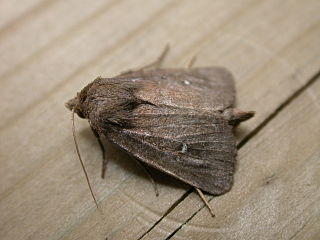
The garden dart is a moth of the family Noctuidae. It is distributed throughout much of the Palearctic. Temperate regions of Europe, Central Asia and North Asia, as well as the mountains of North Africa. Absent from polar regions, on Iceland and some Mediterranean islands, as well as in Macaronesia.

The square-spot rustic is a moth of the family Noctuidae. It is found in Europe, North Africa and east across the Palearctic and in North America.

Apamea crenata, known as the clouded-bordered brindle, is a moth in the family Noctuidae. It is distributed throughout the Palearctic realm. In the North it crosses the Arctic Circle, in the Mediterranean it is found only in cool locations and mountains avoiding very hot areas. In the Alps, it rises to an altitude of about 2000 metres.

The herald is a moth of the family Erebidae. The species was first described by Carl Linnaeus in his 1758 10th edition of Systema Naturae. It is found throughout the Palearctic and Nearctic (Holarctic).

Conistra erythrocephala, the red-headed chestnut, is a moth of the family Noctuidae. It is distributed throughout Europe. and it is recorded from Asia Minor, (Amasia).

The Treble Lines(Charanyca trigrammica) is a moth of the family Noctuidae. It is found virtually throughout Europe.In addition, there are occurrences in Asia minor and the Caucasus.In the mountains it rises to altitudes of 1000 metres.

Orthosia incerta, the clouded drab, is a species of moth of the family Noctuoidea. It is found in Europe. The occurrence of the species extends through all European countries through the Palearctic to the Russian Far East and Japan. It is absent from northern Fennoscandia. In the Alps it occurs up to 2000 m above sea level.

Mormo maura, the old lady or black underwing, is a species of moth of the family Noctuidae. The species was first described by Carl Linnaeus in the 10th edition of his Systema Naturae. It is found in the Palearctic realm, from north-western Africa through all over southern Europe. It reaches its northern border in the west in northern Ireland and central Scotland, in central Europe, in northern Germany and Poland. In some Nordic countries, there are single finds. The other occurrence areas include Turkestan, Anatolia, the Middle East and Iraq. The name "old lady" refers to the fact that the wing pattern was said to resemble the shawls worn by elderly Victorian ladies.

Fissipunctia ypsillon, the dingy shears, is a species of moth of the family Noctuidae. It is found in the Palearctic realm.

Archanara geminipuncta, the twin-spotted wainscot, is a moth of the family Noctuidae which is found in Europe, Lebanon, Israel, Turkey, Iraq and the Caucasus. The species was first described by Adrian Hardy Haworth in 1809.

Helotropha leucostigma, the crescent, formerly Celaena leucostigma is a moth of the family Noctuidae. It is found in the Palearctic realm.

Conistra rubiginea, the dotted chestnut, is a moth of the family Noctuidae. The species was first described by Michael Denis and Ignaz Schiffermüller in 1775. It is distributed in Europe and, according to William Warren, Armenia and Asia Minor.

Pachetra is a monotypic moth genus of the family Noctuidae erected by Achille Guenée in 1841. Its only species, Pachetra sagittigera, the feathered ear, was first described by Johann Siegfried Hufnagel in 1766. It is found in central and southern Europe, east to the Ural, north to southern England, Sweden and Finland. Southwards it is found from Anatolia, central Asia and the Altai up to Mongolia. It is also present in North Africa.

Catocala nymphagoga, the oak yellow underwing, is a moth of the family Erebidae. It is found in Southern Europe, from Bulgaria up to the Iberian Peninsula and sometimes further north as a migrant. It is also found in North Africa and Asia Minor.

Mesapamea secalis, the common rustic, is a moth of the family Noctuidae. The species was first described by Carl Linnaeus in his 1758 10th edition of Systema Naturae. It is found in Europe, north-west Africa, Turkey and northern Iran.

Agrotis vestigialis, the archer's dart, is a moth of the family Noctuidae. The species was first described by Johann Siegfried Hufnagel in 1766. It is found in most of the Palearctic realm from Ireland east, through to Russia, Siberia, the Altai mountains and the Amur region, and is also present in the Mediterranean Basin. It is absent from the north of Finland and Norway.

Lygephila craccae, the scarce blackneck, is a moth of the family Erebidae. It is found in temperate Europe and across the Palearctic to the Altai Mountains, Korea, Japan and China.

Agrotis trux, the crescent dart, is a moth of the family Noctuidae. The species was first described by Jacob Hübner in 1824. It has a circum-Mediterranean distribution and is found along the coasts of France, Ireland, England, southern Europe, Algeria, Syria, Iraq, Iran, southern Russia and the Arabian Peninsula. In Africa, it is found as far south as South Africa.

Apamea oblonga, the crescent striped, is a moth of the family Noctuidae. The species was first described by Adrian Hardy Haworth in 1809. It is found in northern and central Europe, east to southern Russia, Asia Minor, Armenia, Turkestan, Turkey, Iran, southern Siberia, northern Pakistan, Mongolia, China, Sakhalin and Japan

Archanara dissoluta, the brown-veined wainscot, is a moth of the family Noctuidae. The species was first described by Georg Friedrich Treitschke in 1825. It is found in most of Europe, east into Russia and Siberia.






















